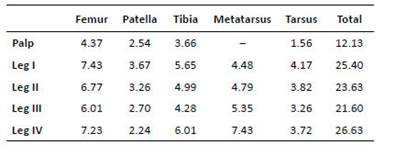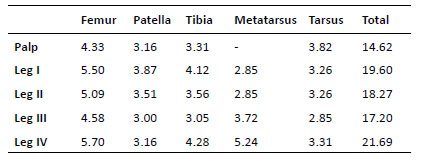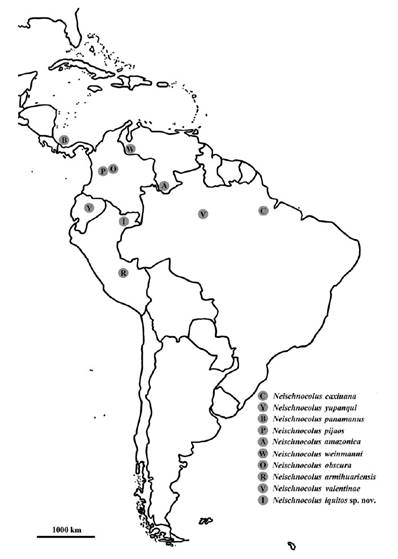Introduction
Pérez-Miles et al. (2008) established the genus Ami Pérez-Miles 2008 to accommodate several small ther- aphosids from Costa Rica, Panama, Colombia, Venezue- la, northern Brazil and Ecuador, characterized by having modified type I urticating setae and other unusual char- acters which did not fit any known theraphosid genus, especially the shape of the spermathecae in females and the presence of one or two subconical processes on the male palpal tibia, in combination with a palpal bulb with very short and stout embolus carrying two well-developed prolateral keels.
More recently, Pérez-Miles, Gabriel & Sherwood (2019) revised Neischnocolus panamanus Petrunkevitch, 1925, the type species of the genus Neischnocolus Petrunkevitch, 1925, and proposed Neischnocolus to be a senior synonym of the genera Ami Pérez-Miles 2008 and Barropelma Chamberlin 1940.
In October 2017, during a fieldwork studying of tarantulas near Iquitos, Loreto, in northern Peru, I got one adult male and one live immature female to be reared and later deposited in the spider collection at the Museum of Natural History in Lima, Peru (MUSM). The female reached maturity in captivity during the following years and it was sacrificed in July 2019. Both specimens from Iquitos were recognized as being a new species of Neischnocolus, distinguishing from other known species by the following combination of morphological features: the male palpal tibia with two retrolateral processes, the palpal bulb with a retrolateral keel, apically converging with a prolateral superior keel, and the female genitalia consisting of a lower sclerotized part with two seminal receptacles, and an upper part, which is transparent and notched. This new species is herein described, diagnosed and figured.
At present the genus Neischnocolus (which is exclusive to tropical regions of South and Central America) comprises nine species: N. amazonica (Jimenez & Bertani 2008), N. armihuariensis (Kaderka 2014), N. caxiuana (Pérez-Miles, Miglio & Bonaldo 2008), N. obscurus (Ausserer 1875), N. panamanus Petrunkevitch 1925, N. pijaos (Jimenez & Bertani 2008), N. valentinae (Almeida, Salvatierra & de Morais 2019), N. weinmanni (Pérez-Miles 2008) and N. yupanquii (Pérez-Miles, Gabriel & Gallon 2008).
Material and methods
Abbreviations: Eye sizes and interdistances: AME = anterior median eyes, ALE = anterior lateral eyes, PME = posterior median eyes, PLE = posterior lateral eyes, OQ = ocular quadrangle (including lateral eyes). Spination: p = prolateral, r = retrolateral, d = dorsal, v = ventral. Male palpal bulb: PS = prolateral superior keel, PI = prolateral inferior keel, A = apical keel, R = retrolateral keel. Cheliceral teeth pattern: v = small teeth, V = big teeth. PLS = posterior lateral spinnerets, PMS = posterior median spinnerets. MUSM = Museo de Historia Natural, Universidad Nacional Mayor de San Marcos, Lima, Peru. RKCP = Radan Kaderka collection, Prague, Czech Republic.
Measurements were taken with an ocular micrometer according to the central axis of structures and are given in millimetres. The measurements of the leg and palpal segments were taken dorsally. The eye measurements were taken from the widest spans of the lens, AME in dorsal view, ALE, PLE and PME in dorsolateral view. The measurement of the total body length including cephalothorax and abdomen without spinnerets was made using an ocular micrometer of a Leica S6D stereomicroscope.
The extent of tarsal and metatarsal scopulae on ventral side of both leg segments was expressed as a percentage of the total length of segment, from apical end.
The leg spination was described using a following method. Each leg segment was divided into four quadrants (ventral, prolateral, retrolateral and dorsal) and each quadrant described separately from basal to apical end. Unequal numbers of spines of the same leg segments on the right and left side were expressed by parentheses.
The terminology of the male palpal bulb structures follows Bertani (2000).
The abdominal urticating setae were sampled using a tweezers, placed in alcohol and examined on a Leica S6D stereomicroscope. The terminology of the urticating setae follows Cooke et al. (1972) and Kaderka et al. (2019). The barbs of the urticating setae whose tips are oriented to the body are considered as reversed.
Other material examined: Neischnocolus yupanquii (Pérez-Miles, Gabriel & Gallon 2008), female (RKCP 0314) from Ecuador, without further data; Neischnocolus sp., immature male from Peru, Loreto, Quebrada Yanayacu, 03°22.548"S, 73°03.798"W, altitude 104 m, October 24, 2018, Diana Silva Dávila & Nolberto Ahuanari col.; Neischnocolus sp., exuvia from Peru, Loreto, Tahuyao River, Chino, 04°18.944"S, 73°13.014"W, altitude 103 m, October 17, 2017, R. Kaderka col.
Taxonomy
Order: Araneae Clerck 1757
Infraorder: Mygalomorphae Pocock 1892 Family: Theraphosidae Thorell 1869 Subfamily: Theraphosinae Thorell 1869 Genus: Neischnocolus Petrunkevitch 1925
Type species: Neischnocolus panamanus Petrunkevitch 1925.
Diagnosis (modified from Pérez-Miles et al. 2008 and Pérez-Miles, Gabriel & Sherwood 2019): Males of Neischnocolus differ from all known Theraphosinae genera in the presence of one or two subconical processes on the retrolateral surface of the male palpal tibia. Males also differ from all Theraphosinae spiders in the palpal organ morphology, having prolateral keels that are more or less convergent. Females of Neischnocolus differ from all other theraphosines in their characteristic spermathecae (Figures 8, 9) with paired ventral receptacles attached to an almost discrete, semicircular, sclerotized back-plate. Males and females have modified abdominal urticating setae of the type I (Cooke et al. 1972), subtype (according Kaderka et al. 2019), similar to those found in Proshapalopus Mello-Leitão 1923 (Bertani 2001) and Citharacanthus Pocock 1901 and in very small nymphs, e.g. of Acanthoscurria Ausserer 1871, with carapace length 1.7 mm (Kaderka et al. 2019).
Neischnocolus iquitos sp. nov.
Figures 1 − 8, 10, Tables 1 - 2
Types: Male holotype (MUSM-ENT 0511874) from Peru, Loreto, Iquitos, Umaral, 03°42.076"S, 73°05.890"W, altitude 101 m, October 20, 2017, Nolberto Ahuanari col.; female paratype (MUSM-ENT 0511873) from Peru, Loreto, Iquitos, Umaral, 03°42.076"S, 73°05.890"W, altitude 101 m, October 20, 2017, Nolberto Ahuanari col.
Etymology: The specific name refers to the native people living in Upper Amazonas, who were called "iquitos" by Spaniards. The name also refers to the type locality occurring near Iquitos, the capital city of Peru's Maynas Province and Loreto Region.
Diagnosis: Males of Neischnocolus iquitos sp. nov. distinguish from all other congeners, except for N. amazonicus, for which the male is uknown, by the following combination of morphological features: the male palpal tibia with two retrolateral processes, the palpal bulb with a retrolateral keel on embolus, apically converging with a prolateral superior keel, and the absence of granulation or microspikes on embolus or tegulum. Females of Neischnocolus iquitos sp. nov. differ from all known Neischnocolus females in the genitalia morphology consisting of a lower sclerotized part of the back-plate with two separate seminal receptacles, and an upper part, which is transparent and notched (Fig. 8).
Remarks: This study shows how the morphology of the spermathecae gradually develops during the process of ontogeny (Figs. 8A−8F) and how important is to know that process for avoiding taxonomic problems due to changes in the spermathecae shape and size. The single developmental stages are chronologically ordered from above downward: Figure 8A, Figures 8B, 8C, Figure 8D and Figures 8E, 8F, respectively.
Distribution (Fig. 10): Known only from the type locality.
Male (MUSM-ENT 0511874) (Figs. 1 − 4): Total length 13.72, carapace length 6.78, width 6.21, chelicerae with 10 − 11 teeth on promargin, with granulation near last two basal teeth. Cheliceral teeth pattern from the basal end: right side: V-V-V-V-v-V-v-V-V-VV, nine big and two small teeth. Left side: V-V-V-v-V-v-V-V-VV, eight big and two small teeth. Anterior eye row procurved, posterior eye row recurved. Eye sizes and interdistances (Fig. 2C): AME 0.44 (circular), ALE 0.45 (oval), PME 0.28 (oval), PLE 0.33 (oval), AME-AME 0.04, AME-ALE 0.05, PME-PME 0.65, PME-PLE 0.02, ALE-PLE 0.08, AME-PME 0.01, OQ length 0.71, width 1.46. Ocular tubercle length 0.91, width 1.46, clypeus absent.
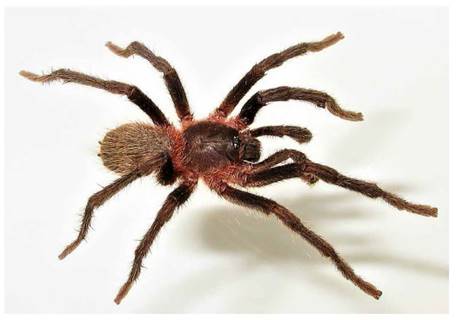
Figure 1 Neischnocolus iquitos sp. nov. from Peru, Iquitos, Umaral, habitus of adult male holotype (MUSM-ENT 0511874), dorsal view.
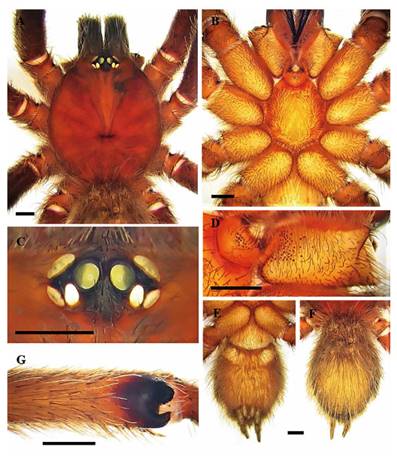
Figure 2 Neischnocolus iquitos sp. nov., male holotype (MUSM-ENT 0511874), Peru, Iquitos, Umaral. A. Carapace, coxae and trochanters, dorsal view. B. Sternum, labium, maxillae and coxae, ventral view. C. Ocular tubercle, dorsal view. D. Labium and left maxilla, ventral view. E. Abdomen, ventral view. F. Abdomen, dorsal view. G. Left tibia I with fused subapical apophyses, prolateral branch incrassate, proventral view. Scale bar = 1 mm.
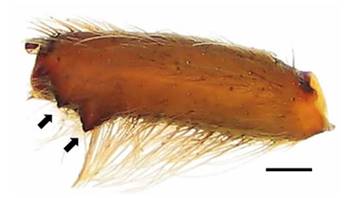
Figure 3 Neischnocolus iquitos sp. nov., male holotype (MUSM-ENT 0511874), Peru, Iquitos, Umaral. Morphology of left palpal tibia, retrolateral view. Arrows show the position of two subconical protuberances on retrolateral side near distal end. Scale bar = 1 mm.
Fovea transverse, slightly procurved, deep, width 0.70, 4.17 from the anterior edge of carapace. Labium length 0.73, width 1.16, anterior half with 15 cuspules, maxilla with 53 − 57 cuspules in basal third (Fig. 2D). Labiosternal sigilla joined. Sternum length 3.35, width 2.80, three pairs of sternal sigilla located near coxae III, coxae II and near coxae I. Leg pattern: IV>I>II>III. Incrassate leg segments absent.
Scopulae: All tarsi 100% scopulate, metatarsi I 70%, metatarsi II 60%, metatarsi III 45% scopulate, metatarsi IV ascopulate. Tarsi I − II with scopula entire, tarsi III distally divided by a narrow longitudinal band of setae, tarsi IV divided by a wide band of setae. Dorsal face of all tarsi and cymbium with two irregular longitudinal rows of very short claviform trichobothria. Denticulation pattern of paired tarsal claws (prolateral / retrolateral row): I 3/4, II 2/4, III 1/4, IV 1/3. Pad of plumose setae on retrolateral face of femur IV absent. Maxillary and trochanteral stridulatory bristles absent.
Spination: tibiae II v 0-0-2 (apical), III v 0-0-3 (apical), p 0-0-1, r 0-0-1, IV v 0-0-3 (apical), p 0-0-1, r 0-0-1 and tibiae of palps p 0-0-1; metatarsi II v 0-1-1 (apical), III v 0-2-3 (apical), p 0-1-1, r 0-0-1, IV v 0-3-1-3 (apical), p 0-2-2, r 0-1-1.
Palpal organ as in Figure 4, embolus short and stout with two well-developed prolateral keels, PS and PI keel, A keel and R keel. PS keel less developed than PI keel, PI keel proximally serrated, A keel small, transparent, R keel convergent with PS keel and of the similar length. Basal area of embolus without micro-spikes (granulation). Tegular protuberance lacking granulation. Subtegulum enlarged, its shape is slightly influenced by a damage on retrolateral side. Cymbium with two unequal lobes, prolateral cymbial lobe larger than retrolateral one.
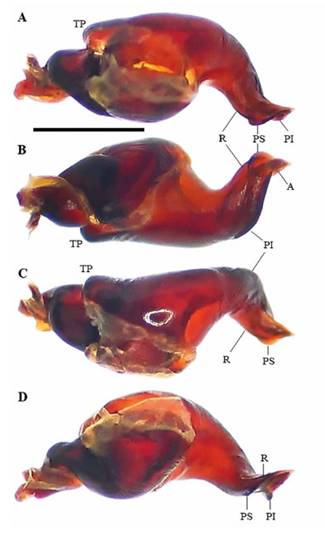
Figure 4 Neischnocolus iquitos sp. nov., male holotype (MUSM-ENT 0511874), Peru, Iquitos, Umaral. Morphology of right male palpal bulb, subtegulum damaged. A. Retrolateral view. B. Prolateral view.
Presence of two distinct subconical median protuberances on retrolateral face of palpal tibia (Fig. 3). Two almost equal tibial apophyses present on tibia I (Fig. 2G), fused in their bases. Ventral tibial apophysis with very short apical spine.
Prolateral tibial apophysis incrassate, with one stout retrolateral spine not reaching the apex. When flexed, metatarsus I comes into contact with the retrolateral side of ventral tibial apophysis. Abdomen with type I urticating setae, subtype I , located in dorsoposterior part. The central section without barbs is approximately eight times longer than central section with reversed barbs. PLS: length 2.64, basal segment 0.89, middle segment 0.73, apical segment 1.02, all digitiform. PMS: length 0.70.
Coloration: dorsal view (Fig. 1): brown, except coxae and trochanters, which are reddish-brown, abdomen brown, covered with long pale setae. Patellae I, II and palpal patella with two almost equal longitudinal stripes without covering pubescence, patellae III, IV with two unequal diagonal stripes. Ventral view (after preservation in alcohol): yellowish brown.
Female (MUSM-ENT 0511873) (Figs. 5 − 8): Total length 20.06, carapace length 8.91, width 8.19, chelicerae with 11 teeth on promargin, with granulation near last two basal teeth. Cheliceral teeth pattern from the basal end: right side: V-V-V-v-V-v-V-VVVV, 9 big and 2 very small teeth. Left side: V-V-V-v-V-v-V-VVVV, 9 big and 2 very small teeth. Anterior eye row procurved, posterior eye row recurved. Eye sizes and interdistances (Fig. 7C): AME 0.44 (circular), ALE 0.47 (oval), PME 0.29 (oval), PLE 0.35 (oval), AME-AME 0.17, AME-ALE 0.13, PME-PME 0.85, PME-PLE 0.05, ALE-PLE 0.11, AME-PME 0.08, OQ length 0.75, width 1.66. Ocular tubercle length 1.20, width 1.66, clypeus narrow, length 0.182. Fovea transverse, slightly procurved, width 1.43, 5.65 from the anterior edge of carapace. Labium length 1.04, width 1.68, anterior half with 19 cuspules, maxilla with 5254 cuspules in basal third (Fig. 7D). Sternum length 4.37, width 3.66, three pairs of sternal sigilla located near coxae III (length 0.34, 0.33 from edge of sternum), coxae II (length 0.19, 0.22 from edge of sternum) and coxae I (length 0.15, 0.23 from edge of sternum). Leg pattern: IV>I>II>III. Incrassate leg segments absent.
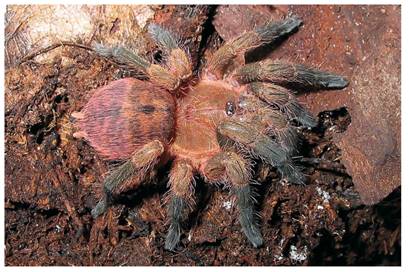
Figure 5 Neischnocolus iquitos sp. nov. from Peru, Iquitos, Umaral, habitus of female paratype (MUSM-ENT 0511873) after ecdysis (March 2019), dorsal view.
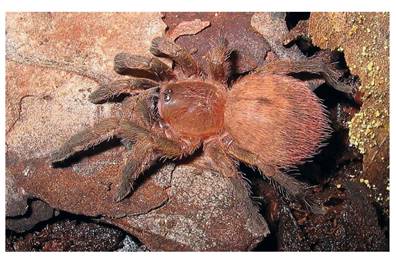
Figure 6 Neischnocolus iquitos sp. nov. from Peru, Iquitos, Umaral, habitus of female paratype (MUSM-ENT 0511873) before ecdysis (March 2018), dorsal view.
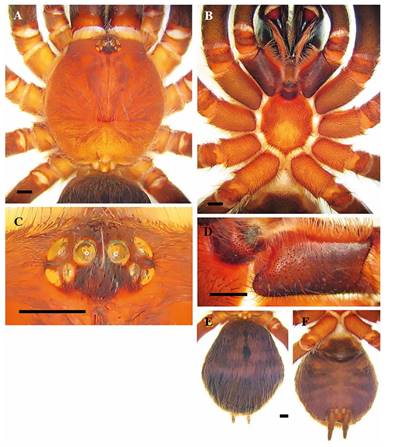
Figure 7 Neischnocolus iquitos sp. nov., female paratype (MUSM-ENT 0511873), Peru, Iquitos, Umaral. A. Carapace, coxae and trochanters, dorsal view. B. Sternum, labium, maxillae, coxae and trochanters, ventral view. C. Ocular tubercle, dorsal view. D. Labium and left maxilla, ventral view. E. Abdomen, dorsal view. F. Abdomen, ventral view. Scale bar = 1 mm.
Scopulae: All tarsi 100% scopulate, metatarsi I 70%, metatarsi II 50%, metatarsi III 30% scopulate, metatarsi IV ascopulate.
C. Dorsal view. D. Ventral view. PS = prolateral superior keel, PI = prolateral inferior keel, A = apical keel, R = retrolateral keel, TP = tegular protuberance. Scale bar = 1 mm.
Tarsi I-II with scopula entire, tarsi III divided by a longitudinal band of setae, tarsi IV divided by a wide band of setae. Dorsal face of all tarsi and cymbium with two irregular longitudinal rows of very short claviform trichobothria. Denticulation pattern of paired tarsal claws (prolateral / retrolateral row): I 4/3, II 4/5, III 3/2, IV 2/0. Pad of plumose setae on retrolateral face of femur IV absent. Maxillary and trochanteral stridulatory bristles absent.
Spination: tibiae I v 0-0-1 (apical), III v 0-0-2 (apical), p 0-1-0, r 0-1-0, IV v 0-0-2 (apical), p 0-1-0, r 0-1-0 and tibiae of palps v 0-0-3 (apical); metatarsi I v 0-1-1 (apical), II v 0-1-3 (apical), III v 0-1-2-3 (apical), p 0-1-1, r 0-1-1, IV v 1-1-2-1-3 (apical), p 0-1-1, r 0-1-1.
Spermathecae as in Figures 8E − 8F, with flattened and partly sclerotized basal atrium and a pair of seminal receptacles projecting on ventral side. The upper part of the basal atrium is transparent and notched.
Abdomen with type I urticating setae, subtype I , located in dorsoposterior part. PLS: length 3.76, basal segment 1.33, middle segment 1.12, apical segment 1.31, all digitiform. PMS: length 0.91.
Coloration of the live female (Fig. 5), a coloration after its preservation in alcohol: dorsal view: carapace yellowish brown, sparsely covered with pubescence, maxillae and trochantera yellowish brown, the rest of legs brown, abdomen dark brown, in anterior half with a few small darker patches arranged in a longitudinal row, and with a few indistinct transverse brown stripes. Patellae I, II and palpal patella with two almost equal longitudinal stripes without covering pubescence, patellae III, IV with two unequal diagonal stripes. Ventral view: labium and maxillae dark brown, chelicerae black, sternum and legs brown, abdomen dark brown, spinnerets light brown.
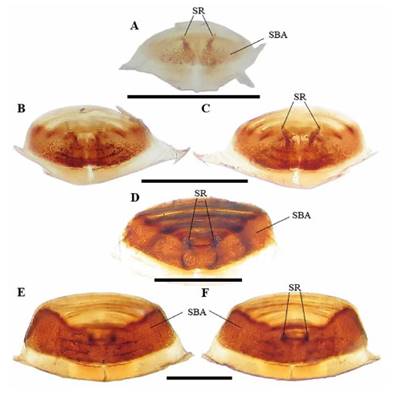
Figure 8 A-F. Neischnocolus iquitos sp. nov., female paratype (MUSM-ENT 0511873) from Peru, Iquitos, Umaral, spermathecae with two coniform receptacles(chronologically ordered from above downward). A. Dissected from exuvia (November 2017), ventral view. B-C. Dissected from exuvia (April 2018). B. Dorsal view. C. Ventral view. D. Dissected from exuvia (August 2018), ventral view. E-F. Dissected from specimen in alcohol (March 2020). E. Dorsal view. F. Ventral view. Abbreviations: SR = seminal receptacles; SBA = flattened and partly sclerotized basal atrium, fused with a ventral part of uterus externus. Scale bar = 1 mm.
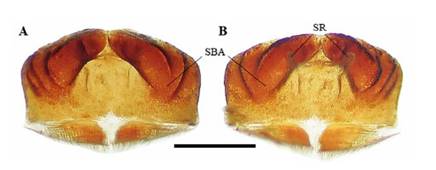
Figure 9 A-B. Neischnocolus yupanquii (Pérez-Miles, Gabriel & Gallon, 2008), female (RKCP 0314) from Ecuador, spermathecae with two coniform receptacles. A. Dorsal view. B. Ventral view. Abbreviations: SR = seminal receptacles; SBA = flattened and partly sclerotized basal atrium, fused with a ventral part of uterus externus. Scale bar = 1 mm.












 uBio
uBio 

